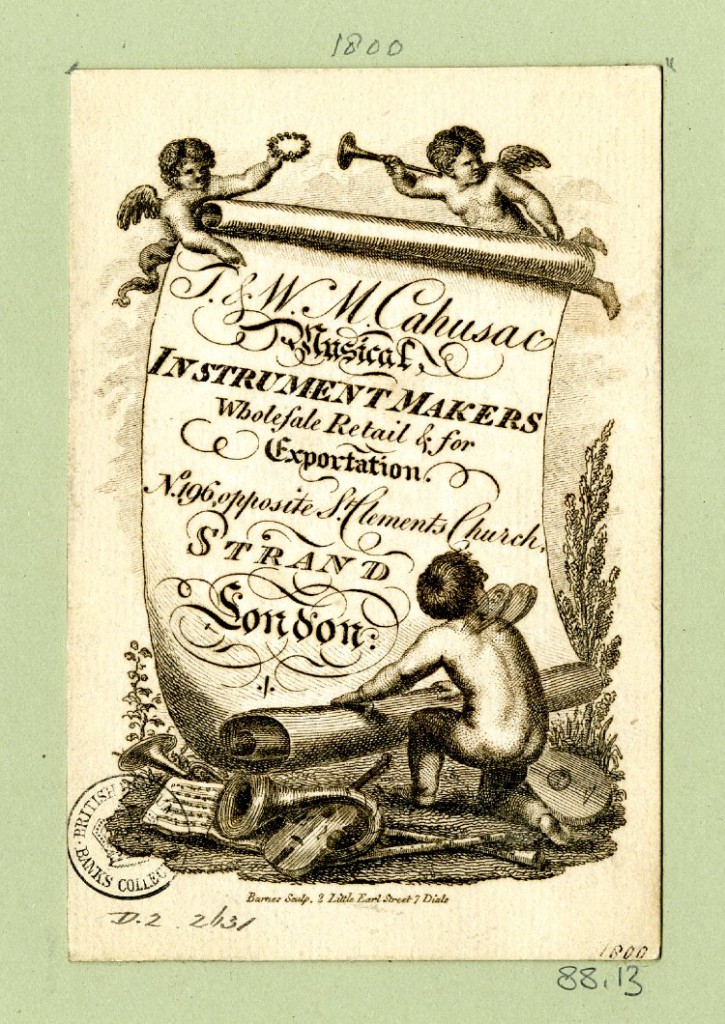“Opposite to St. Clements Church in ye Strand”: A Musical Pilgrimage
During the second half of the 18th century, the sign depicting the “Two Flutes and Violin” marked the shop of Thomas Cahusac, Sr. (1714-1798), a musical instrument maker, “Opposite to St. Clements Church in ye Strand London.” On the first day of our English Design History trip we walked right through the area where Cahusac worked and lived, led by our tour guide Angus Lockyear. As we passed St. Clement’s Church, I became a musical pilgrim, snapping photos of the surrounding buildings and construction zones. Just a few years ago, I reproduced an instrument that Cahusac made in his shop on that very street.[1]
As his shop sign indicates, Cahusac specialized in woodwind and stringed instruments. A few of his instruments are now in the collections of the Metropolitan Museum of Art, the Library of Congress, and the National Music Museum at the University of South Dakota. Beginning in 1794, Cahusac worked with two of his sons, Thomas, Jr. and William Maurice. When Thomas, Sr. died in 1798, his sons remained business partners for the next two years. After 1800, they had separate instrument shops.[2]
 Trade card for Thomas, Jr. and William Maurice Cahusac, c. 1800 (courtesy of the British Museum)
Trade card for Thomas, Jr. and William Maurice Cahusac, c. 1800 (courtesy of the British Museum)
 Early 20th century photograph of a miniature of Thomas Cahusac, Jr., dated 1800 (courtesy of the Library of Congress)
Early 20th century photograph of a miniature of Thomas Cahusac, Jr., dated 1800 (courtesy of the Library of Congress)
I became interested in Thomas Cahusac, Sr. after Steve Dillon, a musical instrument maker in Woodbridge, NJ, made me aware that Cahusac made fifes for the British Army during the period of the American War for Independence. According to his trade card from 1780, Cahusac made “Fifes for the Army” as well as high-end flutes, oboes, and clarinets for civilian musicians. A few Cahusac-marked fifes survive, including one at the Birmingham Conservatoire at Birmingham City University in England and one at the Metropolitan Museum of Art. Steve, who is also a fife collector, owns a boxwood Cahusac fife as part of his personal collection. Surviving fifes with direct connections to the War for Independence are rare. Steve has previously suggested that, because of the listing in Cahusac’s 1780 trade card, it is possible that the surviving Cahusac fifes date to the period of the American War for Independence and were meant for use by fifers in the British Army.[3]
 Fifer of the 25th Regiment. Detail from “Lady Louisa Lennox with her husband’s Regiment, 25th Regiment of Foot with Lord George Lennox beside her, and Fort St Philip, Port Mahon, in the background, 1771” (courtesy of the National Army Museum, London)
Fifer of the 25th Regiment. Detail from “Lady Louisa Lennox with her husband’s Regiment, 25th Regiment of Foot with Lord George Lennox beside her, and Fort St Philip, Port Mahon, in the background, 1771” (courtesy of the National Army Museum, London)
As a high school woodshop project, I decided to make a reproduction of one of the surviving Cahusac fifes. I planned to play it at living history demonstrations and at my job as an historical interpreter at Washington Crossing State Park in New Jersey. Steve generously provided me with measurements, diagrams, and helpful instruction regarding the Cahusac fife he owns. He also makes reproductions of it.
Due to their shorter length, smaller finger holes, and small embouchure hole, Cahusac fifes produce a different sound than fifes played by most modern fife and drum corps. Therefore, when I play the fife I made, I am interpreting how one type of fife from the period of the American War for Independence actually sounded. It is a high-pitched, shrill sound meant to be heard over long distances. In contrast, modern fifes, through still high-pitched and loud, produce a relatively mellow sound.
Making the fife allowed me to develop my woodworking skills. Even though I had used a lathe before to turn bowls, I learned new turning techniques and enhanced my familiarity with the variety of chisels that are used with the machine. I also needed to make wooden mandrils and jigs so I could attach the fife to the lathe and drill the finger holes and embouchure hole. At the time, I did not have access to a supply of boxwood so I decided to make the fife out of ebony. Ebony is an appealing instrument wood due to its dark color and high-density. His trade cards and surviving instruments provide evidence that Thomas Cahusac, Sr. made instruments out of ebony, imported from Africa, in his shop in London. Overall, the fife came out great and it is quite the conversation piece. Now I can add more to those conversations because I have actually been “Opposite to St. Clements Church in ye Strand.”[4]
[1] Cahusac’s trade card from c. 175o is reprinted in Ardall Powell, The Flute (New Haven, CT: Yale University Press, 2002), 87, accessed February 20, 2015, Google Books.
[2] Frank Kidson, British Music Publishers, Printers and Engravers: London, Provincial, Scottish, and Irish (London: W.E. Hill, 1900), 21-22, accessed February 20, 2015, Google Books; William Waterhouse, The New Langwill Index (London: Tony Bingham, 1993), 54-55.
[3] Cahusac’s 1780 trade card is transcribed here, Waterhouse, 54-55; Steve Dillon, “What does a Revolutionary War fife look like?,” Dillon Music, accessed February 20, 2015, http://dillonmusic.com/historic_fifes/whatdoes.htm.
[4] Waterhouse, 55.
By Matthew Skic, Winterthur Program in American Material Culture, Class of 2016



